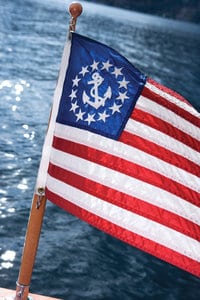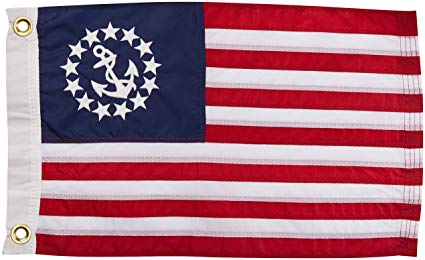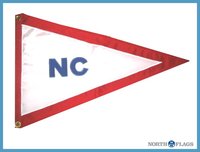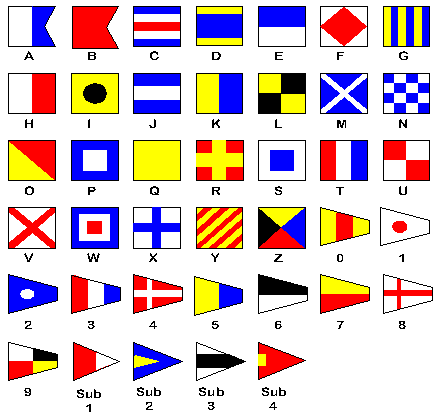
Flag etiquette has been passed down to us by generations of mariners. It is often totally lacking or incorrectly displayed on pleasure yachts, in particular charter yachts.
We are not totally fanatical about flag etiquette, but we like to observe at least the minimum requirements of this age old tradition and basic rules.
First, Some History
The earliest use of flags to communicate between vessels in ancient marine fleets. The very limited expressions were mainly used to rally a convention of the sailors to discuss a decision or course of action. As shipping commerce and naval wars became commonplace in the 18th century, the use of flag display on vessels was rapidly adopted and frequently improved.
In 1738, Mahé de la Bourdonniase, a French naval officer, created the first numerical flag codes that greatly increased the number of communications as a mere 3 flags offered 1,000 combinations and later served as the basis for flag-hoisting signaling. The beginning of the more complex system we follow today began in the mid-1700s during the Anglo-Dutch naval wars. The formalization of the new flag communication methods that offered 45 mixed messages using 11 flags was called “Royal Navy’s Permanent Fighting Instructions“. Interesting side note: Rudyard Kipling (the famous poet) had a fascination with all things naval and was actually an advisor for the development of this publication.
In 1783, Richard Earl Howe, First Lord of the Admiralty, recast the French system by adding repeater pennants and control flags. These modifications led to publication of the “1799 Signal Book for Ships of War“. The Royal Navy used its individual flag designs through the Napoleonic Wars and the War of 1912. Popham’s Telegraphic Signals or Marine Vocabulary further expanded the signaling to include 6,000 phrases and 60,000 words.
At the same time, the United States was innovating its maritime communications. In 1797, the US published its first numerical code system entitled “Instructions, Signals, and Explanations Ordered for the United States Fleet”. Followed in 1817 by the first commercial book of signals, “Code of Signals for the Merchant Service” authored by Captain Frederick Marryat of the Royal Navy. The American government published J.R. Parker’s “American Signal Book for the Use of Vessels Employed in the United States Naval, Revenue, and Merchant Service” for use in non-tactical communications and it was in use until 1856, when it was rendered obsolete by technological advances. The British Board of Trade took up creating an improved code that later became the International Code of Signals.
The first International Code of Signals was created by the British Board of Trade in 1855 and published in 1857. It contained 70,000 signals and 17,000 messages using 18 flags. During the International Radiotelegraph Conference of Madrid in 1932, the code was revised with 6 more flags for different languages including French, Italian, German, Japanese, Norwegian, and Spanish. In 1947, the Inter-Governmental Maritime Consultative Organization (IMO) began governing the Code. In 1969, more flags were added to accommodate the Greek and Russian languages and each alpha-numeric signal flag was assigned meaning.
Flag Etiquette
As you can see the code can be quite complex but there are only a few that are important to recreational sailors.
The Ensign: Boats Should Fly “Country of Origin” or National Flag
 US-registered boats have a choice of two flags to fly to show country of origin while in US waters:
US-registered boats have a choice of two flags to fly to show country of origin while in US waters:
- The Yacht Ensign, with its fouled anchor over a circle of 13 stars, the “Betsy Ross” flag. Originally restricted to documented vessels only, it is now commonly flown on recreational boats of all types and sizes instead of the National Flag.
- or the 50-star flag “Old Glory” you are all familiar with.
The appropriate time to fly the ensign is from sunrise to sunset, except when racing. However, whenever a boat is taken into international or foreign waters, the 50-star U.S. national flag is the proper flag to fly and the yacht ensign should not be displayed. In other words, if you own a US boat in the British Virgin Islands, you should not fly the Ensign, but the National Flag.
Boats today fly the Yacht Ensign from the stern, which provides the best visibility or at the lower third of your mizzen sail (generally from the mizzen’s topping lift). When flown from the stern, it should be on a staff (pole) that is sufficiently long and angled, and that is offset to one side (traditionally the starboard side), so the flag flies clear of engine exhaust and rigging.
Courtesy Flag & “Q” (Quarantine) Flag
 If you are in foreign waters, a courtesy flag should be flown from your main mast’s starboard spreader. Once out of foreign waters, the courtesy flag should be removed.
If you are in foreign waters, a courtesy flag should be flown from your main mast’s starboard spreader. Once out of foreign waters, the courtesy flag should be removed.
If you are preparing to clear customs while returning from foreign waters, the “Q” flag should be flown on your starboard spreader, below the country’s courtesy flag. Once formalities are taken care of, immediately remove the “Q” flag.
All charter boats should carry the national flags of neighboring islands as well as the yellow “Q” flag in case charterers want to visit those islands. As a side note, some authorities are not amused at all if you fly their courtesy flag using an old, raggy flag. Some will even fine you for disrespect. So check your flags before setting off to another country to ensure the flags look good enough to display!
Burgee
 The burgee is a small flag displaying the symbol of the skipper’s yacht club or other sailing organization.
The burgee is a small flag displaying the symbol of the skipper’s yacht club or other sailing organization.
It may be flown day and night. Many people opt to fly the burgee lower in the rig hoisted to the end of the lowest starboard spreader on a thin flag halyard. While purists rail this practice, it is an accepted adaptation of another tradition which is that the starboard rigging is a position of honor.
Note that when you visit a foreign port, that’s where you fly the host country’s flag. Besides being reasonable, flying the burgee in the starboard rigging is such a widespread custom that to try to end it would be close to impossible.
Private Signal
A private signal is a small, custom-designed and custom-made flag that carries symbols for/about the owner of the flag and can basically be anything. The signal may be flown day or night, but is not displayed when another skipper is in command. (The rule is: the private signal and burgee follow the sailor, not the boat.)
On a multi-masted boat, the private signal is flown at the head of the aftermost mast. On a sloop, the private signal may be flown from the starboard rigging, either below the burgee or alone.
Lastly, it is also a common courtesy to fly the national flag(s) of your guest(s) on board, if they have a different nationality than the ensign is showing. This flag/flags should be flown on the port spreader lower than the courtesy flag as a sign of respect for the host country.
Flag Dimensions
Although flags come in standardized sizes, there are guidelines to help you selecting the proper size for your boat.
The size of a nautical flag is determined by the size of the boat that flies it. Flags are more often too small than too large. So in the rules below, round upward to the nearest larger standard size.
The flag at the stern of your boat: U.S. ensign or national flag should be about one inch for each foot of overall length. For example, on a 40ft. boat, the ensign should be 40 in. which about 3.5 ft or 1 meter.
Other flags, such as club burgees, private signals and courtesy flags for use on sailboats, should be approximately 1/2 inch for each foot of the highest mast above the water. For example, on a 30ft. boat, with 50ft. between the masthead and the water, the burgee should be about 25 in. i.e. about 2 ft. The shape and proportions of pennants and burgees will be prescribed by the organization which they relate to.
Raising and Lowering Flags
 Fly the ensign from morning (8:00 a.m.) to evening (sunset) whether the boat is at rest, under sail, or under power. The exception to this rule is: The ensign is not flown on a boat in a race. The absence of the ensign signals to other boats that you are racing.
Fly the ensign from morning (8:00 a.m.) to evening (sunset) whether the boat is at rest, under sail, or under power. The exception to this rule is: The ensign is not flown on a boat in a race. The absence of the ensign signals to other boats that you are racing.
To prevent wear and tear, the flag may not be flown when out of sight of other vessels or when nobody is aboard. The flag is flown while entering or leaving a port even at night. For purists: in the morning, the ensign is hoisted rapidly before other flags. In the evening, it is lowered slowly and with ceremony after other flags come down.
Signal Flag Meanings
Today, even with modern communications, signal flags are used whether the vessel is a Navy boat, sailboat, or fishing vessel. Each signal flag has its own unique meaning that is affected by context The meaning can differ depending if you’re in a sailing reggata or if you’re in the Navy.
The point of using the flags is to clear up the communication path between sailors. People use nautical flags to express a status, warning or a need.to neighboring vessels without a chance of misinterpretation.
Each flag does have its own letter, but it is rarely used for spelling as used of words is less effective when there are language barriers. The flags are useful because each one has its unique meaning.
Download the International Code flags and their meanings.
Sail With Us to Learn


Week-Long Liveaboard Courses
Rare RYA Classes & Certifications
Catamaran Guru’s real-life practical methods combined with up-to-date sailing theory in lessons aboard recent model catamarans…or your own boat!
Prepare for certifications or take the first step aboard to embark on your dream life of boat ownership or cruising
Classes in S Florida and the Bahamas.





